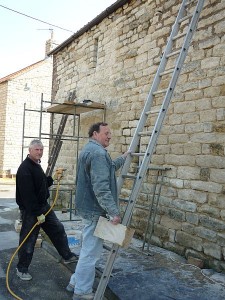For more than six years David Silversides and his wife Dawn were involved in a project to renovate two farm buildings which once formed part of Oak Farm – buildings which they believe were “very definitely worth saving”.
As both buildings fell within the curtilage of Oak Farm, a Grade ll Listed Building, special care was taken with the building alterations and restoration.
One of the last tasks for what is now known as The Old Barn was re-pointing the west wall which fronts Main Street (Moor Lane).
The old sand and cement mortar was dug out and replaced with a lime mortar, the traditional material used during the original construction. In some places the original lime mortar could still be seen.
David explained that sand and cement mortar is bad for stone work, particularly limestone. Although some of the stones are sandstone, notably those at the foot of the wall, many are limestone, including some from Hildenley, regarded as a better quality limestone. These are distinguished from other limestone because their structure is different; they are denser and harder wearing. This makes them clearly visible as these are the stones which jut out as they are not weather-perished.
Need to replace frost damaged stones
Some stone has perished sufficiently to merit replacing. While some stones used for replacement came from the building itself – for example, where spaces were created for windows – others had to be sourced from a variety of places.
Not all the damaged stones were changed. David is deliberatelyleft some of the stones with frost-shattered faces which were earlier patched-up with sand and cement. Because sand and cement chemically sets, it was much preferred by many, especially farmers.
“Not only did farmers use sand and cement as it was easier because it is quick drying, it was also a cheap way of repairing a building,” said David. “This sort of repair can be found on many farm buildings, making it part of farming history.”
He explained that although the lime mortar was slightly more expensive, the main difference was that it needed to dry out slowly and had to be kept moist to prevent it from cracking; hence the need for the hosepipe during dry spells! A major advantage is that lime mortar will not crack with any slight movement in the building.
Garden wall
The walls of the buildings are not the only ones to be restored – in the mid 20th Century, render was put on a garden wall to form a backdrop to a livestock pen. The render was cracking with water and therefore frost getting in between the wall and the render. As the ends of the wall, which separate Oak Farm garden from the old fold yard, are brick-built, it was assumed the whole of the wall would be similarly built.
But to the delight of David and Dawn, removing the render revealed a stone wall which stands some 14feet tall. It too has been re-pointed and will form a focal point of The Old Barn garden.
AGW 2011

Speak Your Mind